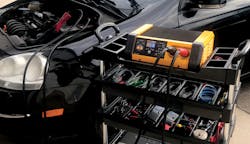When it comes to module reprogramming, there is so much information out there for busy shops and technicians to keep up with. Even if you confine your focus to just the power requirements related to module reprogramming, it can still be overwhelming. Different OEs call for different power needs, in terms of both system voltage and available current, to keep up with expected demand. Even within a single make, the power requirements can shift drastically from model to model and among different model years. So, this month, we thought we would address a few of these issues to (hopefully) help shed some light on this topic.
The key is to give the system what it wants and needs
Since introducing our flashing power supply Models PL6100 and PL6800, one of the key things we have tried to impress upon service operations is the need to calibrate the output of the power supply to specifically meet the OE-recommended power parameters for the vehicle under service.
When it comes to meeting the recommended power parameters, it starts with the OE-recommended voltage environment in which the reflash will take place. Different manufacturers recommend very different voltage targets, which can include prescriber voltages of >12V, 13.4V, 13.7V, 14.2V, etc. It is critical that a service operation utilize a power supply that can dial in the specific recommended voltage target to 0.1V. PRO-LOGIX flashing power supplies can support system voltages from 13.1-14.9V, adjustable in 0.1V increments. This allows an operator to exactly match the OE-recommended system voltage.
The second key component of the recommended power parameters is the current (amperage) available to support the system by offsetting the loads that occur during the reflash event. Each OE has a recommended minimum current required to successfully support their reflash routines. These minimum current requirements vary from 55A to 100A, as well as just about everything in between. So, the higher the current output capability, the greater the vehicle coverage.
The beauty of power supply operation is that you don’t need different models to support different current requirements. You just need to meet or exceed the highest current requirement among the makes you service. This is because a flashing power supply doesn’t work like a battery charger, where you set the output to 20A and it delivers a 20A charging routine. Instead, the flashing power supply is voltage-driven, such that you set the desired voltage level, say at 13.7V, and the power supply will provide the current necessary (up to its max output) to maintain that level, raising and lowering its current output based on system demand.
With 100A max output with no limitation on the length at which they can operate at 100A, our PL6100 and PL6800 models can support the flash reprogramming power needs of virtually any make or model on the road today. Realistically, the output should really be called 0-100A, on demand, as they will manage the output such that exactly the amount of power needed to maintain the desired voltage is provided. So, if the demand required to maintain 13.7V is 8A, the power supply will output 8A. If load demand increases and 62A is needed to maintain 13.7V, then the PL6100/PL6800 increases its output to 62A.
And, the PL6100 and PL6800 react quickly and precisely to changes in load demand, which is critical, as seen in the below referenced article. If the recommended voltage level is not maintained, the reflash event can get derailed, resulting in the need to start all over again (best case) or a bricked module (worst case), as seen in a recent TSB article related to reprogramming the Porsche Cayenne. Here is an excerpt from that TSB: “If a low voltage condition occurs while being programmed, …the module may be rendered permanently inoperable.” Also noted in the TSB are the specific power parameters required for a successful reflash event:
“The electrical system of a well-equipped vehicle can draw more than 40 AMPs of current with the ignition switched on. It is important that a clean microprocessor-controlled power supply be connected to a vehicle whenever the ignition is switched on and the vehicle’s engine is not running. Never use an unregulated, high output battery charger on these vehicles. The power supply must have a minimum continuous output capability of 40 Amps at 13.8 VDC under load. With the ignition switched on, the output of most power supplies will be 14.2 to 14.5 VDC. A vehicle voltage below 13.8 VDC under load may indicate that the capacity of the power supply has been exceeded. The voltage supplied to the vehicle must never exceed 14.5 VDC for more than a few moments. A sustained voltage above 14.5 VDC will dry out and permanently damage the glass mat in the cells of the AGM battery.”
As the above reference illustrates, vehicle reprogramming can be painstaking and difficult. One great way to reduce the complexity of this application is by choosing a power supply that puts you in control and gives the vehicle’s system exactly what it needs. A precise, microprocessor-controlled power supply, such as our PL6100 or PL6800, is essential equipment for this task.
Information provided by Clore Automotive
About the Author

Jim O' Hara
Clore Automotive
Jim O'Hara has over 15 years experience in the Tool and Equipment industry, including 10+ years at Clore Automotive. At Clore, he heads up the marketing team and is directly involved in the development of new products and enhancements of existing products.
